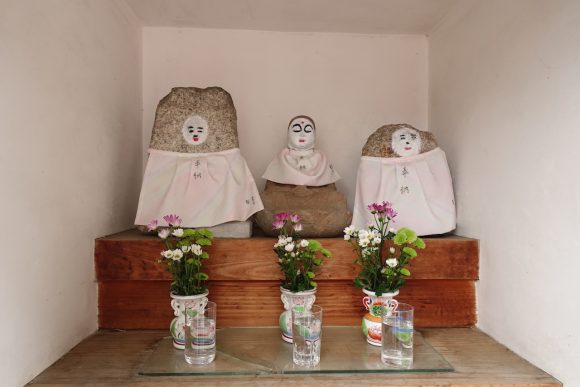This town surprises me every day. Often I feel as if I am just superficially grasping at the surface of things. I wish I could come back and discover more. Temples, gardens, and historic places seem to invite me in. A lot of these places are frequented by people donating something at a shrine, bow down, clap their hands twice, and stay there for a short while. There is a house right next to the shrine. Gardening tools are witnesses of tireless upkeep and care. On the day the beauty of the Kennin-Ji temple makes me hold my breath in awe, John Einarsen lends my experience some context with his historical knowledge: He tells me that this is the place that the Japanese first made tea. Monks had brought it from China. The local priests noticed its effects and started cultivating the enjoyable treat.
Kennin-Ji is located in Higashiyama, adjacent to the historical quarter Gion, where a lot of Geikos and Meikos live. Rules have been set for the narrow alleys crowded by tourists: no molesting the women, no selfie sticks, no smoking or eating on the streets. This is not usually done anyway. “To go” hasn’t arrived here yet. Public garbage cans are rare. Just a few streets further, on the canal, things are placid again. At a construction site, I watch two men warning pedestrians, cyclists, and car drivers of the potential diversion by the roadwork. Inconceivable in Germany!
Kyoto, that’s also countless bicycles and their gallery thanks to Günther, a perceived similarity with France, elegant people, craftsmanship and modern art, that’s hippie neighborhoods with vegan restaurants like Padma Zen Food, it’s delicious matcha and lots of miles on foot. Last night, I dreamt I were still there. I took a photo, intense dark blue and light. I had to work a little on the DOF to show exactly what I saw.
A ten-day Miksang workshop was at the heart of my trip to Kyoto. That workshop also would be described well by the catchphrase subtle abundance.
Before I left, I had already subscribed to Instagram feeds devoted to life in Kyoto. I had purchased several online issues of the Kyoto-Journal and Deep Kyoto Walks, a rich source of commended walks trough the city. Every year, the annual festival Kyotographie invites visitors to literature readings and art exhibitions at various special locations.
More about my Japan travels
Tokyo’s Kindness
100% Rain
Japanese Tradition
Click on the first image to look at the images in full screen.

Wenn ich so Deine wunderbaren Fotos herunter-scrolle, eröffnet sich mir nach und nach die Überfülle der exotischen Schönheit dieses Landes (durch Dein wirklich “gutes” Auge) – wie bei einem großen Feuerwerk entfalten sich immer neue, noch schönere Bilder… Wunderbar!